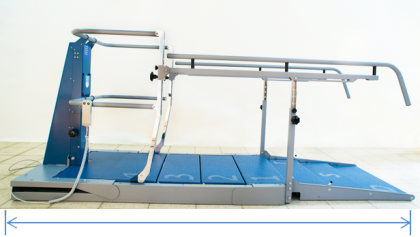Dynamic Stair Trainer 8000 With Hand Rail Adjustable
Manufactured By :
DPE Medical, Israel 
Available Options :
This product is not available in stock.
Dynamic Stair Trainer 8000
For 15 years, this remarkable Dynamic Stair Trainer has helped millions of patients throughout the world to return to their daily life.
Dynamic stair case:
It is the only staircase trainer that helps patients train stair climbing.
The ability to adjust the height of the stairs to the patient's current ability and gradually increase the height between the stairs as the patient progress is the key factor in the enormous success of this product.
Benefits:
-
Reciprocal ascension of stairs.
-
Increased patient motivation.
-
Independent practice.
For more comprehensive information on the advantages of the DST.
Practicing stairs climbing at an earlier stage of rehabilitation.
Because the stairs can be adjusted very accurately to the patient’s level of ability, exercise could begin at an earlier stage of rehabilitation. On regular stairs or on a wooden- step device, the height of the stairs is set, usually at 16.5 centimeters (6.5 inches). A patient who cannot yet climb stairs of this height cannot begin stepping exercises. With the Dynamic Stair Trainer - DST, we can adjust the height of the adjustable stairs to exactly what the patient is able to do and thus begin exercise at an earlier stage. To view the full specification of the medical equipment of DPE Medical go to: Dynamic Stair Trainer 8000, Dynamic Stair Trainer Compact.
Some patients began climbing stairs at a height difference of one centimeter and within two days succeeded in climbing stairs three centimeters high. Five days later they could already climb eight-centimeter stairs. By introducing this exercise at such an early stage, the entire rate of the patient’s rehabilitation progress increased – not only the ability to climb stairs, but also the ability to walk.
Reciprocal ascension of stairs
The Dynamic Stair Trainer - DST allowed patients to ascend and descend stairs reciprocally. A common phenomenon among people with one weak leg is to climb stairs by leading with the strong leg and dragging the weaker one up to it. By adjusting the Dynamic Stair Trainer - DST to the functional level of the weaker leg, patients succeeded in climbing stairs reciprocally, rather than by dragging the weaker leg to catch up with the stronger one. The exercise contributed greatly to the patients’ progress, and eventually we were able to increase the height of the stairs while maintaining reciprocal ascent.
Increased patient motivation
An interesting and important aspect of the use of Dynamic Stair Trainer - DST was the dramatic increase in patients’ motivation to perform the exercise. We know that exercising on stairs can be fraught with frustration, pain and anxiety. Adjusting the height of the steps precisely to the current ability of the patient affords a feeling of achievement as well as reassurance that they will be able to perform this important exercise after their release from hospital. As one patient said “Now I’ll be able to climb the stairs at home.” This increased motivation was visible in the patient’s willingness and desire to exercise.
Patients would go up and down the stairs several times, with the physiotherapist increasing the height of the steps from time to time. They could actually see their own improvement as they found themselves able to ascend stairs at a height that only a few days before had been too high for them.
The modern design of this medical equipment and its electrical self-adjustment mechanism gave the patients a feeling of being in a fitness room rather than in a hospital. One patient said: “It’s a real high-tech instrument”.
By the end of the treatment, both the patient and the physiotherapist were convinced that the improvement, which in the past entailed great effort, time, and often frustration and pain, was accomplished much more quickly and easily using the Dynamic Stair Trainer - DST.
Adjustable handrail height and width
The possibility of adjusting the height of, and distance between, the handrails afforded the staff much greater flexibility in practice. With the height of the rail adjusted to suit the patient’s height and condition, the patient could concentrate more firmly on his main task of rehabilitation stairs. see Width Adjustable Hand rail for more information.
Adjusting the distance between the rails enabled patients who required it to ascend with handrail support on both sides. Other patients, in contrast, needed greater distance between the rails so that they could hold onto the handrail with one hand and an auxiliary aid, such as a cane or walker, with the other.
Independent practice
The adjustability of the stairs and the handrails as well as the general safety of the device allowed some patients to practice independently after receiving appropriate guidelines from the physiotherapist. Independent practice also accelerated the rehabilitation process and enhanced the patients’ self-confidence.
Shortening rehabilitation time
In essence, all the points mentioned above contributed to reducing the time required to acquire step climbing skills and thus of the entire rehabilitation process. The saving in time required to learn to cope with steps was at times quite dramatic. An article by Richard Bohannon that explain the importance of stair training - Why Train on Stairs.
Adoption of the Dynamic Stair Trainer DST by the staff
It usually takes quite some time for a medical staff to adopt a new medical equipment or apparatus. With the Dynamic Stair Trainer - DST, the medical staff was exceptionally enthusiastic and responses such as “Where has this device been until now?” and “How did we get along without it until now?” were common.
Savings and efficiency
The Dynamic Stair Trainer - DST saved us treatment time and made our work more efficient. Instead of improvising all kind of platforms with stairs of different heights to meet the patient’s needs, the physiotherapist simply pressed the button and immediately had a device that was perfectly adjusted. The fact that step-height could be adjusted to the patient’s ability to practice by himself also helped. For example, this freed the physiotherapist to work with someone else while giving instructions and taking an occasional look at the patient working by himself on the DST.
The Dynamic Stair Trainer 8000 can accommodate patients who weigh up to 270 Kg (600 Lib
Specification:
Model : 8000
Shipment dimensions : 210x104x72cm (83x42x30in)
Weight : 250Kg (550 lbs)
Stair width (regular) : 74 cm (29 inches)
Stair height range : 0-16.5 cm (0-6.5 inches)
Capacity (static) : 300 Kg (660 lbs)
Electrical requirements : 100-240V, 50/60Hz, 4A max
Operating interval : 2 min on / 18 min off
Regulatory compliance : IEC 601-1 CE, UL (motor, controls)
For more information:



